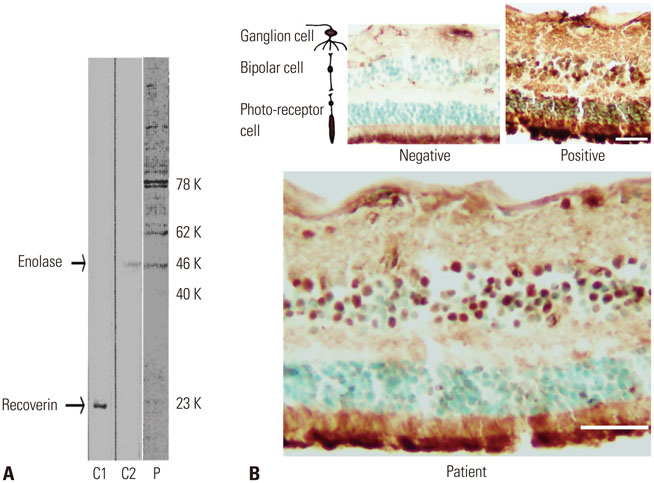Yonsei Med J.
2016 Mar;57(2):527-531. 10.3349/ymj.2016.57.2.527.
Non-Paraneoplastic Autoimmune Retinopathy: The First Case Report in Korea
- Affiliations
-
- 1Department of Ophthalmology, Gangnam Severance Hospital, Yonsei University College of Medicine, Seoul, Korea. minkim76@hotmail.com
- 2Ocular Immunology Laboratory, Casey Eye Institute-BRB, Oregon Health & Science University, Portland, OR, USA.
- 3The Institute of Vision Research, Department of Ophthalmology, Severance Hospital, Yonsei University College of Medicine, Seoul, Korea.
- KMID: 2374064
- DOI: http://doi.org/10.3349/ymj.2016.57.2.527
Abstract
- Autoimmune retinopathy (AIR) is an immune-mediated retinopathy, resulting from an immunologic process caused by the aberrant recognition of retinal antigens as autoantigens. The diagnosis of AIR involves the detection of antiretinal antibodies with concurrent clinical and electrophysiological evidence of retinopathy. A 40-year-old patient presented with progressive loss of bilateral vision over several months. A fundus examination was unremarkable. Spectral domain optical coherence tomography revealed a blurred photoreceptor ellipsoid zone at the subfoveal region in both eyes with more prominent disruption in the left eye. Full-field electroretinography (ERG) showed relatively normal rod and cone responses in the right eye, and decreased photopic bwaves with minimal attenuation of a-waves in the left eye. Multifocal ERG demonstrated slightly reduced amplitude of the inner segment ring in the right eye and decreased amplitudes and delayed latencies of all modalities in the left eye. The patient was suspected to have AIR and it was supported by positive Western blots for 23-kDa protein, enolase (46-kDa), aldolase (40-kDa), 62-kDa and 78-kDa proteins and by immunohistochemical staining of human retinal bipolar and ganglion cells. Despite the immunosuppressive treatment, the destruction of the retinal photoreceptors progressed, and immunosuppressive interventions produced very little visual improvement. We report on what is, to the best of our knowledge, the very first case of serologically confirmed nonparaneoplastic AIR in Korea.
Keyword
MeSH Terms
-
Autoantibodies/*blood/immunology
Autoantigens
Autoimmune Diseases/*immunology
Electroretinography
Humans
Immunologic Factors
Paraneoplastic Syndromes/*immunology
Paraneoplastic Syndromes, Ocular
Phosphopyruvate Hydratase
Recoverin
Republic of Korea
Retina/*immunology
Retinal Diseases/*immunology
Tomography, Optical Coherence
Autoantibodies
Autoantigens
Immunologic Factors
Phosphopyruvate Hydratase
Recoverin
Figure
Reference
-
1. Grewal DS, Fishman GA, Jampol LM. Autoimmune retinopathy and antiretinal antibodies: a review. Retina. 2014; 34:827–845.2. Heckenlively JR, Ferreyra HA. Autoimmune retinopathy: a review and summary. Semin Immunopathol. 2008; 30:127–134.
Article3. Weleber RG, Watzke RC, Shults WT, Trzupek KM, Heckenlively JR, Egan RA, et al. Clinical and electrophysiologic characterization of paraneoplastic and autoimmune retinopathies associated with antienolase antibodies. Am J Ophthalmol. 2005; 139:780–794.
Article4. Adamus G. Autoantibody targets and their cancer relationship in the pathogenicity of paraneoplastic retinopathy. Autoimmun Rev. 2009; 8:410–414.
Article5. Goetgebuer G, Kestelyn-Stevens AM, De Laey JJ, Kestelyn P, Leroy BP. Cancer-associated retinopathy (CAR) with electronegative ERG: a case report. Doc Ophthalmol. 2008; 116:49–55.
Article6. Keltner JL, Thirkill CE, Yip PT. Clinical and immunologic characteristics of melanoma-associated retinopathy syndrome: eleven new cases and a review of 51 previously published cases. J Neuroophthalmol. 2001; 21:173–187.
Article7. Gass JD, Gieser RG, Wilkinson CP, Beahm DE, Pautler SE. Bilateral diffuse uveal melanocytic proliferation in patients with occult carcinoma. 1990. Retina. 2003; 23:6 Suppl. 527–533.8. Whitcup SM, Vistica BP, Milam AH, Nussenblatt RB, Gery I. Recoverin-associated retinopathy: a clinically and immunologically distinctive disease. Am J Ophthalmol. 1998; 126:230–237.
Article9. Adamus G, Ren G, Weleber RG. Autoantibodies against retinal proteins in paraneoplastic and autoimmune retinopathy. BMC Ophthalmol. 2004; 4:5.
Article10. Adamus G, Karren L. Autoimmunity against carbonic anhydrase II affects retinal cell functions in autoimmune retinopathy. J Autoimmun. 2009; 32:133–139.
Article11. Ferreyra HA, Jayasundera T, Khan NW, He S, Lu Y, Heckenlively JR. Management of autoimmune retinopathies with immunosuppression. Arch Ophthalmol. 2009; 127:390–397.
Article
- Full Text Links
- Actions
-
Cited
- CITED
-
- Close
- Share
- Similar articles
-
- A Case of Paraneoplastic Autoimmune Retinopathy in a Young Man with Testicular Cancer
- An unusual type of cancer-associated retinopathy in a patient with ovarian cancer
- Myelitis Presenting Anti-Yo Antibody in a Patient with Prostatic Adenocarcinoma
- A Case of Cancer Associated Retinopathy with Small Cell Lung Carcinoma
- Anti-Yo-associated paraneoplastic cerebellar degeneration in a patient with chemotherapy-responsive ovarian cancer: A case report with a review of literatures




